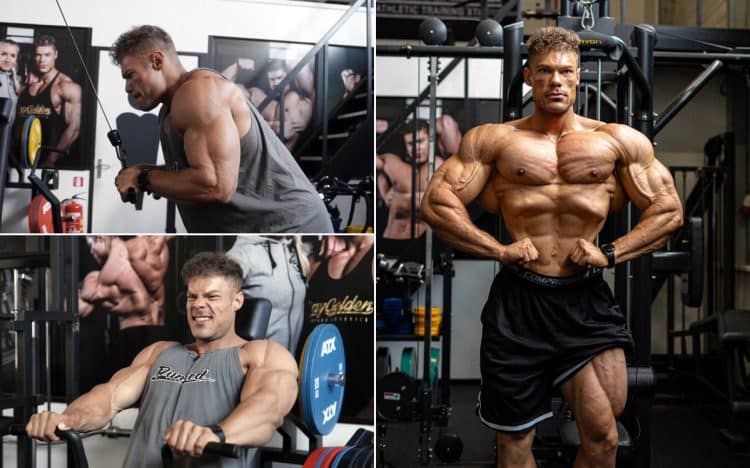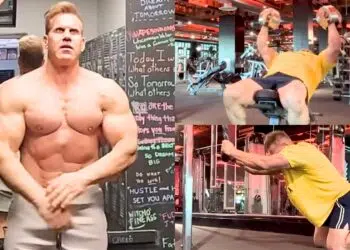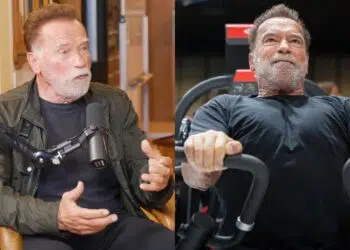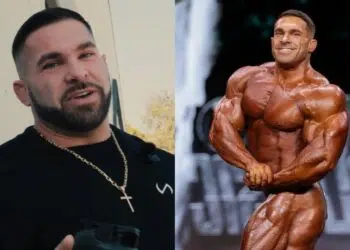Bodybuilder Wesley Vissers recently tackled a push-day workout to get ready for the next Pro show. He has a short window to get the 2023 Olympia qualification and hopes to qualify for the show and continue to pursue his Olympia dream.
Wesley Vissers is a Dutch professional bodybuilder who competes in the Classic Physique division of the IFBB Pro League. The 30-year-old bodybuilder is a four-time Olympia participant. He made the Classic Physique Olympia debut with a sixteenth-place finish in 2018 and has graced the stage every year since then. Visser’s best Olympia performance came in 2022 where he finished eighth in the Classic Physique division.
2023 Olympia will take place from Nov.3-5 in Orlando, Florida and the cut-off date for the qualification is October 9, 2023. Wesley Vissers has to win a pro show to be able to show his talent on the grandest stage of bodybuilding. He will compete at the 2023 Europa Pro, an Olympia qualifier, on September 17. Recently, he went through a push-day workout to get ready for the show and posted the video of this session on his YouTube channel.
Wesley Vissers goes through a chest workout
At the time of recording this video, Wesley Vissers was four weeks out of Europa Pro. The Dutch bodybuilder felt that he was stage-ready in terms of conditioning.
Level Up Your Fitness: Join our 💪 strong community in Fitness Volt Newsletter. Get daily inspiration, expert-backed workouts, nutrition tips, the latest in strength sports, and the support you need to reach your goals. Subscribe for free!
“So these (remaining) four weeks (before the show) will be all about recovery, digging just a little bit deeper but not digging every single day…”
However, maintaining strength is also his priority at the moment. While speaking about the training strategy for the rest of his competition prep, Wesley Vissers added:
“When you maintain strength, you maintain muscle mass. That is all we want to keep during the prep. You don’t want to think about growing into the show. Yes, you’ll look bigger anyway when dropping the fats… That’s the funny thing about bodybuilding. You lose 15 kilos and you look 15 kilos heavier. But you don’t actually have to grow muscle for this.”
With that, the 30-year-old headed straight to the gym to do the day’s work. Let’s take a closer look at the detailed account of this training session and try to understand his training method.
Machine Decline Chest Press
Vissers started the workout with a machine chest press. He positioned himself on the chest press machine in such a way that his arms moved at a decline angle and allowed a deeper stretch. This way, his shoulders moved at a more natural angle as well. Since this was the first exercise of the day, the Classic Physique competitor approached it with caution and performed warm-up sets to prepare his body for the workout.
“When I warm up, I literally reduce the weight. The first few sets are higher reps. But the higher the weight becomes, the less reps I do to preserve all of my energy for working sets…” Vissers said.
He then continued on to do the working sets. Vissers maintained three-minute rest periods between the sets to preserve the energy as the caloric intake at the moment is lower than usual. Additionally, the 30-year-old stated that pushing to failure in each set demands longer rest periods between the sets. According to him, it does not have hypertrophic benefits when you are in a caloric deficit. As a result, Vissers stops a few reps short of failure in each set.
Incline Smith Machine Bench Press
The free weight incline barbell press is Wesley Vissers’ go-to movement in the off-season. But he prefers using a Smith machine during contest prep as it eliminates a lot of balancing work, need for the spotter and enables training at a balanced pace. Once again, Vissers initiated the exercise with warm-up sets and advanced over to the working sets. The Dutch bodybuilder shared his wisdom with the viewers and explained the correct mechanics for getting the most out of this exercise:
“Go all the way down because the stretch is where the growth happens. Then don’t go all the way up. You don’t want your elbows to be extended. You want the tension to remain on your chest. So go about 80 – 85 percent up and then go straight down to give it tension there. Make it more effective and… it should simply cause less joint pain that way.”
According to Vissers, locking out the weight at the top could be one of the reasons why many people experience joint pain during exercise.
He started the working sets with heavier weights and reduced the weight for the subsequent sets to reduce the stress on connecting tissues.
Cable Flyes
Vissers took to the standing cable flyes next and performed this exercise on a specialized machine that enabled him to place the arms closer to the body. This way, he could get a better stretch in the back and the pushing muscles could move at a more natural angle. The 2019 Romania Muscle Fest Pro winner tackled two working sets of cable flyes to get a good pump in the chest. This exercise served as the finisher to chest training as Vissers shifted his focus to working the triceps next.
View this post on InstagramGet Fitter, FasterLevel Up Your Fitness: Join our 💪 strong community in Fitness Volt Newsletter. Get daily inspiration, expert-backed workouts, nutrition tips, the latest in strength sports, and the support you need to reach your goals. Subscribe for free!
Cable Triceps Pushdown
The triceps portion of the push day workout started with cable triceps pushdown. Vissers used a v-bar attachment for doing this exercise. While some people avoid the attachment due to the angle of the wrist, Vissers thinks otherwise:
“It just feels incredible to me. It doesn’t hurt the joints at all even though the grip doesn’t line up perfectly with the elbow.”
The 30-year-old bodybuilder is careful to not force the contraction when he is all the way down during this exercise. He feels that forcing the contraction could lead to elbow pain. He
Overhead Cable Triceps Extension
Overhead triceps exercises emphasize the long head of the triceps. Wesley Vissers targeted this part of the muscle with overhead cable triceps extensions next and performed this exercise unilaterally. For doing an exercise unilaterally, Wesley suggested following this universal rule:
“Always start out with your weakest arm. Do as many reps there as you can and then try to match it with your stronger arm unless the stronger arm is also kind of smaller in terms of size.”
The Dutch bodybuilder cranked out two working sets of overhead cable triceps extensions before jumping into the final exercise of the day.
“Maximize the stretch and don’t over emphasize the contraction here because then there’s no tension anymore on the triceps. So focus mostly on the stretch here,” Vissers gave the last piece of advice as he changed the stations.
Sideways Incline Dumbbell Lateral Raise
The Classic Physique competitor capped the push-day workout with this medial deltoid-focused exercise. While the standing or seated lateral raise is the most common medial / side delt exercise, Vissers prefers the sideways incline variation of the movement. Why? Because according to him:
“When you’re in the incline, the tension on the delts will be a lot more… A lot more towards the bottom and towards the top as well. Especially towards the bottom because when you stand (upright), there’s no tension because you’re literally just up against gravity, going down with your arm down.”
Vissers further stated:
“When (you’re in a sideways incline position)… your body is now pointing in the other direction. Meaning, there’s tension (in the arm movement), there is resistance here.”
For doing this exercise, Wesley Vissers used lighter weights and kept the muscles under tension for a longer duration through higher volume. After executing some arduous sets of the exercise, unilaterally of course, Vissers wrapped up his training session and called it a day in the gym.
Overall, the workout included:
- Machine Decline Chest Press – 3 sets (160 kg for 13 reps, 140 kg for 14 reps, 130 kg for 15 reps)
- Incline Smith Machine Bench Press – 3 sets (130 kg for 11 reps, 110 kg for 14 reps, 110 kg for 11 reps)
- Cable Flyes – 2 sets (25 kg for 14 reps, 25 kg for 11 reps)
- Cable Triceps Pushdown – 3 sets (98 kg for 15 reps, 98 kg for 14 reps, 92 kg for 16 reps)
- Overhead Cable Triceps Extension – 2 sets (31.5 kg for 16 reps, 31.5 kg for 14 reps)
- Sideways Incline Dumbbell Lateral Raise – 3 sets (10 kg for 15+ reps in each set)
Wesley Vissers reiterated that being in the later stages of the competition prep, his energy levels are low. As a result, proper recovery is essential and the meals consumed around the workout time are of utmost importance to ensure good results. The Classic Physique competitor consumed his high carbohydrate post-workout meal to restore the glycogen stores that were depleted after the workout.
“Sooner you refill the glycogen stores, although partially, it will recover your muscles a lot quicker,” Wesley Vissers claimed.
Vissers is yet to qualify for the 2023 Olympia. But staying the course with a proper diet and training routine will certainly be beneficial when he steps on stage at the 2023 Europa Pro. The weight limit for Wesley Vissers as per the revised Classic Physique criteria is 112.9 kg. A couple of days after the workout, the 30-year-old was hovering in the 112.5 kg territory. He is now working to lower it down further to be in the 111.5 kg range to have sufficient buffer.
You can watch the full chest workout video below, courtesy of Wesley Vissers’ personal YouTube channel:









